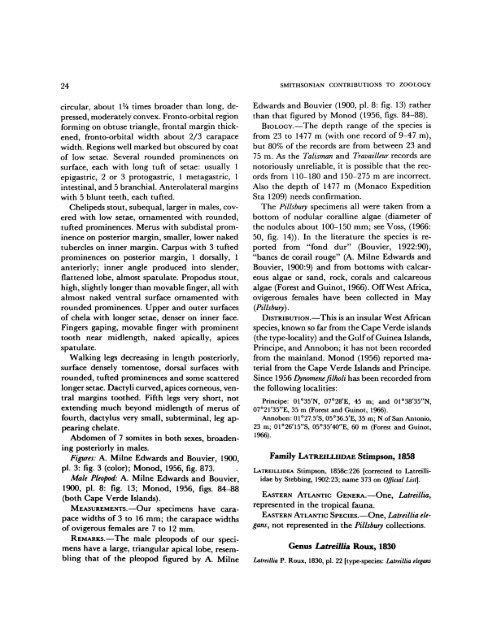West African Brachyuran Crabs - Smithsonian Institution Libraries
West African Brachyuran Crabs - Smithsonian Institution Libraries
West African Brachyuran Crabs - Smithsonian Institution Libraries
Create successful ePaper yourself
Turn your PDF publications into a flip-book with our unique Google optimized e-Paper software.
24<br />
circular, about IV4 times broader than long, depressed,<br />
moderately convex. Fronto-orbital region<br />
forming on obtuse triangle, frontal margin thickened,<br />
fronto-orbital width about 2/3 carapace<br />
width. Regions well marked but obscured by coat<br />
of low setae. Several rounded prominences on<br />
surface, each with long tuft of setae: usually 1<br />
epigastric, 2 or 3 protogastric, 1 metagastric, 1<br />
intestinal, and 5 branchial. Anterolateral margins<br />
with 5 blunt teeth, each tufted.<br />
Chelipeds stout, subequal, larger in males, covered<br />
with low setae, ornamented with rounded,<br />
tufted prominences. Merus with subdistal prominence<br />
on posterior margin, smaller, lower naked<br />
tubercles on inner margin. Carpus with 3 tufted<br />
prominences on posterior margin, 1 dorsally, 1<br />
anteriorly; inner angle produced into slender,<br />
flattened lobe, almost spatulate. Propodus stout,<br />
high, slightly longer than movable finger, all with<br />
almost naked ventral surface ornamented with<br />
rounded prominences. Upper and outer surfaces<br />
of chela with longer setae, denser on inner face.<br />
Fingers gaping, movable finger with prominent<br />
tooth near midlength, naked apically, apices<br />
spatulate.<br />
Walking legs decreasing in length posteriorly,<br />
surface densely tomentose, dorsal surfaces with<br />
rounded, tufted prominences and some scattered<br />
longer setae. Dactyli curved, apices corneous, ventral<br />
margins toothed. Fifth legs very short, not<br />
extending much beyond midlength of merus of<br />
fourth, dactylus very small, subterminal, leg appearing<br />
chelate.<br />
Abdomen of 7 somites in both sexes, broadening<br />
posteriorly in males.<br />
Figures: A. Milne Edwards and Bouvier, 1900,<br />
pi. 3: fig. 3 (color); Monod, 1956, fig. 873.<br />
Male Pleopod: A. Milne Edwards and Bouvier,<br />
1900, pi. 8: fig. 13; Monod, 1956, figs. 84-88<br />
(both Cape Verde Islands).<br />
MEASUREMENTS.—Our specimens have carapace<br />
widths of 3 to 16 mm; the carapace widths<br />
of ovigerous females are 7 to 12 mm.<br />
REMARKS.—The male pleopods of our specimens<br />
have a large, triangular apical lobe, resembling<br />
that of the pleopod figured by A. Milne<br />
SMITHSONIAN CONTRIBUTIONS TO ZOOLOGY<br />
Edwards and Bouvier (1900, pi. 8: fig. 13) rather<br />
than that figured by Monod (1956, figs. 84-88).<br />
BIOLOGY.—The depth range of the species is<br />
from 23 to 1477 m (with one record of 9-47 m),<br />
but 80% of the records are from between 23 and<br />
75 m. As the Talisman and Travailleur records are<br />
notoriously unreliable, it is possible that the records<br />
from 110-180 and 150-275 m are incorrect.<br />
Also the depth of 1477 m (Monaco Expedition<br />
Sta 1209) needs confirmation.<br />
The Pillsbury specimens all were taken from a<br />
bottom of nodular coralline algae (diameter of<br />
the nodules about 100-150 mm; see Voss, (1966:<br />
50, fig. 14)). In the literature the species is reported<br />
from "fond dur" (Bouvier, 1922:90),<br />
"banes de corail rouge" (A. Milne Edwards and<br />
Bouvier, 1900:9) and from bottoms with calcareous<br />
algae or sand, rock, corals and calcareous<br />
algae (Forest and Guinot, 1966). Off <strong>West</strong> Africa,<br />
ovigerous females have been collected in May<br />
{Pillsbury).<br />
DISTRIBUTION.—This is an insular <strong>West</strong> <strong>African</strong><br />
species, known so far from the Cape Verde islands<br />
(the type-locality) and the Gulf of Guinea Islands,<br />
Principe, and Annobon; it has not been recorded<br />
from the mainland. Monod (1956) reported material<br />
from the Cape Verde Islands and Principe.<br />
Since 1956 Dynomene filholi has been recorded from<br />
the following localities:<br />
Principe: 01°35'N, O7°28'E, 45 m; and 01°38'35"N,<br />
07°21'35"E, 35 m (Forest and Guinot, 1966).<br />
Annobon: O1°27.5'S, 05°36.5'E, 35 m; N of San Antonio,<br />
23 m; 01°26'15"S, 05°35'40"E, 60 m (Forest and Guinot,<br />
1966).<br />
Family LATREILLIIDAE Stimpson, 1858<br />
LATREILLIDEA Stimpson, 1858c:226 [corrected to Latreilliidae<br />
by Stebbing, 1902:23; name 373 on Official List].<br />
EASTERN ATLANTIC GENERA.—One, Latreillia,<br />
represented in the tropical fauna.<br />
EASTERN ATLANTIC SPECIES.—One, Latreillia elegans,<br />
not represented in the Pillsbury collections.<br />
Genus Latreillia Roux, 1830<br />
Latreillia P. Roux, 1830, pi. 22 [type-species: Latreillia elegans

















